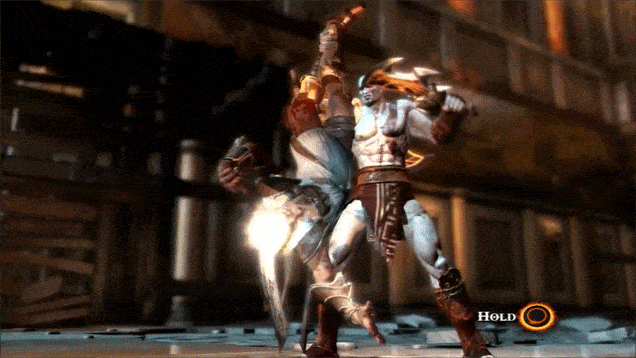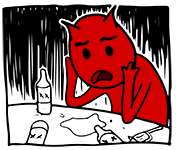Playing through Digital Devil Saga 1 & 2 as my first foray into SMT/its spinoffs. I just finished 1 and really enjoyed it, it's a very solid 8/10 at least. Some thoughts:
- The combat system is relatively simple and won't take long to learn, but offers quite a lot of ways to exploit it. Hitting enemy weaknesses only uses half a turn, just like passing does, which allows you to hit for up to 6 times on your turn using your 3 regular turns if you play your cards right. Learning those weaknesses a lot of work considering how many types of demons there are, but quite often they can be derived logically. Other times it's complete guesswork when the demon in question is based on some obscure spirit from Japanese folklore. It's particularly important to not use attacks that enemies void, expel or drain since that'll use up double turns and damage you/heal the enemy.
- Skill development favors heavily investing into single elements, because each tier requires the previous one to be unlocked and completed for you to move on to the next one. I only ever grinded once for a short while to unlock some fire spells for a boss that was weak against them. Buying those skill packs (Mantras) gets quite expensive so you will often be in a situation where half of your party is only gaining experience to level up but none to earn those skills since you've already mastered the old Mantra but can't afford the next one. I used the double exp/halved encounter rate cheat to make random encounters worth fighting while making them more rare so that I don't overlevel the dungeons. You can distribute skill points on your main character as you level up, but your other party members distribute them semi-randomly which inevitably leads to your main character being considerably stronger than your other members since he can be optimized. My Serph maxed out his Magic around level 40 when he was 61 at the end of the game. During the last quarter of the game he became my main nuker since he dealt about twice the damage as any other member and I made sure to unlock his Mantras first. I wouldn't say I ever felt overpowered though, the difficulty was very fair throughout, but I did end up looking up walkthroughs for most of the bosses just to know their weaknesses and what they nulled so that I could prepare. The last boss was more in the way of 'epic' than genuinely difficult, but I did have Serph nuking the shit out of it with buffed ice magic while the rest of the party focused around dealing with the rare bits he couldn't handle, and to buff and heal him. So I think being able to distribute your party's stats would've gone a decent way in preventing this kind of focus on one character that the game promotes.
I have to give the devs credits in how they handled the way you gain new party members though, you start off with 3 and get your 4th and 5th over a decently long spread, but they come at a competitive level and with plenty of skills unlocked. The game does the mandatory thing of sometimes removing party members, one guy in particular, but they always return at a good level and with their current Mantra mastered, so they're never dragging behind the rest of the party once you get them back.
- Dungeon design was very average. The game does a decent job aesthetically to make you feel like you're not progressing through series of corridors, but in the end the game in its entirety consists of one dungeon after another with some puzzles thrown in. Serviceable, but nothing to write home about.
- Speaking of aesthetics, the game has aged really well on that front, owing to its stylized graphics. I upped the resolution a lot and got rid of the terrible motion blur. I'm a sucker for the artist's style in general.
- Music is great with some odd bits. The battle themes are all very solid (though based on some listening on Youtube, I would say some games in the series pull ahead) while the dungeon and overworld music can be rather bland or odd sometimes. It does a fine job of conveying this otherworldly and lonely feel though. There's plenty of good guitar shredding with electronics motifs. Case in point, one of the regular battle themes:
Early impressions of 2:
- They've added good amounts of flavor in a variety of ways. You can now equip rings and upgrade them (first game only ever had bullet types you could change, and almost never used), you sometimes find loot on levelup, and the Mantra system now works in a grid rather than a tree to encourage learning more types of skills. Sometimes you enter battle only half transformed which comes with extra rewards but also hefty limitations. Some old demons, some new. I was told to get good skills for all characters (1 favored you focusing on 4 out of 5 at most) due to story reasons, and I'm already taking what I learned from 1 and learning useful spells early and actually having one party member focus on physical.
Edit: I have to rant about the way you unlock extra bosses in 1 though. You have to reach the very last room of the last dungeon, after which you can't turn back, actually reach the top of that room (simply entering and using the nearby save terminal to teleport out won't do) and then talk to a soldier to be able to encounter some extra bosses in the dungeons you've already cleared, these being more difficult than the actual last boss. I did all that and... They still didn't spawn, despite me doing everything walkthroughs told me to. Imagine trying to figure out this shit on your own back in the day if you had no access to walkthroughs.
![The Year of Incline [2014] Codex 2014](/forums/smiles/campaign_tags/campaign_incline2014.png)





































